A Statistical Prediction Model for Sluice Seepage Based on MHHO-BiLSTM
Abstract
1. Introduction
2. Principles of the MHHO-BiLSTM Model
2.1. Statistical Model of Sluice Seepage
2.2. BiLSTM
2.2.1. Principles of LSTM
2.2.2. Principles of BiLSTM
2.3. MHHO Optimizes BiLSTM
2.3.1. MHHO
Harris Hawks Optimization (HHO)
- (a)
- Exploration phase
- (b)
- Development phase
Multi-Decision Improved Harris Hawks Optimization Algorithm (MHHO)
- (a)
- Cauchy variation
- (b)
- The random shrinking exponential function
- (c)
- The adaptive weight
2.3.2. The Establishment Process of the Sluice Seepage Prediction Model Based on MHHO-BiLSTM
2.4. Evaluation Method for the Effectiveness of the Prediction Model
3. Case Study
3.1. The Seepage Prediction of Sluice Based on Statistical Model
3.2. The BiLSTM Network Model Training and Prediction
3.3. The Establishment and Prediction of the MHHO-BiLSTM Model
3.4. The Comparison of Model Accuracy
4. Conclusions
- (1)
- According to the results of the main influencing factors of seepage, MHHO was introduced to optimize the BiLSTM model and establish the seepage model of the sluice. The model increases the correlation coefficient R2 from 0.8923 to 0.9942 and decreases the root-mean-square error RMSE from 0.2412 to 0.0530. Compared with the BiLSTM model and stepwise regression model, the R2 value and RMSE value of the predicted results of this method are the largest and the smallest. Case study analysis shows that the MHHO-BiLSTM model has good predictive performance, which indicates the good predictive ability of long-term data series.
- (2)
- The MHHO optimization algorithm can help the BiLSTM model find the optimal parameter combination: the number of forward neurons and the number of backward neurons, so as to improve the performance of the BiLSTM model. The global search capability of the MHHO optimization algorithm can help regulate the complexity of the BiLSTM model to reduce the risk of overfitting, thereby improving the generalization ability of the BiLSTM model on previously unseen data. MHHO optimization algorithm has a strong global search ability, which can help accelerate the convergence process of the BiLSTM model and reduce the training time and calculation cost. MHHO optimization algorithm may help to improve the performance of the BiLSTM model when dealing with long-term dependence and strengthen its modeling ability for long-term dependence by optimizing parameters or model structure.
- (3)
- Sluice seepage problems involve time series data, and BiLSTM is able to consider both the current moment input and the previous and subsequent input information. This enables BiLSTM to more comprehensively capture the time before and after information and timing patterns in the sluice seepage data, which helps to better understand and model the seepage behavior. BiLSTM has strong modeling capabilities and can handle complex nonlinear relationships and timing dependencies. The seepage problem of sluice often involves many influencing factors, and the relationship between these factors may be complicated. BiLSTM is able to build a model and make predictions by learning the temporal patterns in the data. BiLSTM’s bidirectional structure allows the entire time series data to be processed at once. This means that BiLSTM is able to use global information to make predictions rather than just local information at the current moment. For the sluice seepage problem, global dependency modeling is helpful to better understand the correlation and influence of different times in the sluice system. In the seepage problem of the sluice gate, there may be a correlation between several variables, such as temperature, water pressure, aging, and so on. BiLSTM can process multiple input variables at the same time, building predictive models by learning the interactions between them. This gives BiLSTM an advantage in solving multivariable problems.
- (4)
- However, BiLSTM models typically require large amounts of data to be trained in order to effectively capture and learn patterns and trends in time series data. If the amount of data available is small, the BiLSTM model may not be adequately trained, resulting in degraded model performance. These disadvantages should be considered comprehensively according to the specific situation, and the use of the BiLSTM model in predicting the seepage problem of sluice should be weighed. Issues such as the amount of data may need to be fully considered to achieve better predictive performance.
Author Contributions
Funding
Data Availability Statement
Conflicts of Interest
References
- Fan, X.; Wu, Z.; Liu, L.; Wen, Y.; Yu, S.; Zhao, Z.; Li, Z. Analysis of Sluice Foundation Seepage Using Monitoring Data and Numerical Simulation. Adv. Civ. Eng. 2019, 2019, 2850916. [Google Scholar] [CrossRef]
- Hong, P.; Cao, B.; Ai, D. Based on the exploration of sluice engineering construction technology in hydraulic engineering. In Proceedings of the Guangzhou Sub-Forum of 2023 Smart City Construction Forum, Guangzhou, China, 26 March 2023. (In Chinese). [Google Scholar]
- Zhou, W. Safety Problems and treatment measures of sluice operation. Sci. Life 2012, 186. (In Chinese) [Google Scholar]
- Li, H. Study on Seepage Flow of the Sluice Foundation Based on AutoBANK Software. Master’s Thesis, Ocean University of China, Qingdao, China, 2015. (In Chinese). [Google Scholar]
- Zhao, Y.; Cai, T.; Li, J.; Gou, J. Study on seepage problem of sluice. Dwelling 2019, 1, 157. (In Chinese) [Google Scholar]
- Zhou, X.; Gu, X.; Yu, M.; Qian, Q. Seismic bearing capacity of shallow foundations resting on rock masses subjected to seismic loads. KSCE J. Civ. Eng. 2016, 20, 216–228. [Google Scholar] [CrossRef]
- Yue, N.; Zhang, D.; Chen, J.; Song, P.; Wang, S.; Qiu, S.; Su, G.H.; Zhang, Y. The development and validation of the inter-wrapper flow model in sodium-cooled fast reactors. Prog. Nucl. Energy 2018, 108, 54–65. [Google Scholar] [CrossRef]
- Pokharel, G.; Honjo, Y. Mapped infinite elements in multilayered seepage analysis. In Computer Methods and Advances in Geomechanics; Balkma: Rotterdam, The Netherlands, 1994; pp. 1243–1248. [Google Scholar]
- Pongsivasathit, S.; Petchgate, W.; Horpibulsuk, S.; Piyaphipat, S. Composite contiguous pile wall and deep mixing column wall as a dam—Design, construction and performance. Case Stud. Constr. Mater. 2022, 16, e00904. [Google Scholar] [CrossRef]
- Zhang, K.; Xu, L.; Qiu, L.; Tan, J.; Yang, C.; Zhang, K. Numerical Analysis of Concrete Gravity Dam Seepage Characteristics Evolution considering the Calcium Leaching Effect. Adv. Civ. Eng. 2021, 2021, 9042863. [Google Scholar] [CrossRef]
- Jia, Y.; Ding, Y.; Wang, X.; Zhang, J.; Chen, X. A Numerical Analysis of the Leakage Characteristics of an Embankment Dam Slope with Internal Erosion. Front. Earth Sci. 2022, 10, 866238. [Google Scholar] [CrossRef]
- Wang, R.; Zhu, Y. Finite element analysis of seepage of earth-rock dams in dry and rainy seasons. IOP Conf. Ser. Earth Environ. Sci. 2019, 344, 012112. [Google Scholar] [CrossRef]
- Sun, Y.; Li, Z.; Yang, K.; Wang, G.; Hu, R. Analysis of the Influence of Water Level Change on the Seepage Field and Stability of a Slope Based on a Numerical Simulation Method. Water 2023, 15, 216. [Google Scholar] [CrossRef]
- Zhang, M.; Yao, D.; Lu, H.; Wang, H. Solution of seepage field in different soil layers of concrete dam foundation by flow net method. IOP Conf. Ser. Earth Environ. Sci. 2020, 546, 052053. [Google Scholar] [CrossRef]
- Bensmaine, A.; Benmebarek, N.; Bensmebarek, S. Numerical Analysis of Seepage Failure Modes of Sandy Soils within a Cylindrical Cofferdam. Civ. Eng. J. 2022, 8, 1388–1405. [Google Scholar] [CrossRef]
- Norouzi, R.; Salmasi, F.; Arvanaghi, H. Uplift pressure and hydraulic gradient in Sabalan Dam. Appl. Water Sci. 2020, 10, 111. [Google Scholar] [CrossRef]
- Chen, Q.; Zhang, P.; Ding, H.; Cong, H.; Yun, L. Study on Seepage Characteristics of Composite Bucket Foundation under Eccentric Load. China Ocean. Eng. 2021, 35, 123–134. [Google Scholar] [CrossRef]
- Liu, B.; Li, J.; Liu, Q.; Liu, X. Analysis of Damage and Permeability Evolution for Mudstone Material under Coupled Stress-Seepage. Materials 2020, 13, 3755. [Google Scholar] [CrossRef] [PubMed]
- Guo, Q.; Huang, J. Analysis of the influence of the interlayer staggered zone in the basalt of Jinsha River Basin on the main buildings. IOP Conf. Ser. Earth Environ. Sci. 2018, 113, 012099. [Google Scholar] [CrossRef]
- Bai, L.; Che, W.; Wang, S. Study on the Influence of Groundwater Seepage on the form of the Layout of Soil Source Heat Pump. Procedia Eng. 2016, 146, 445–449. [Google Scholar] [CrossRef][Green Version]
- Safari Ghaleh, R.; Aminoroayaie Yamini, O.; Mousavi, S.H.; Kavianpour, M.R. Numerical Modeling of Failure Mechanisms in Articulated Concrete Block Mattress as a Sustainable Coastal Protection Structure. Sustainability 2021, 13, 12794. [Google Scholar] [CrossRef]
- Hou, W.; Wen, Y.; Deng, G.; Zhang, Y.; Wang, X. A multi-target prediction model for dam seepage field. Front. Earth Sci. 2023, 11, 1156114. [Google Scholar] [CrossRef]
- Zhao, M.; Jiang, H.; Chen, S.; Bie, Y. Prediction of Seepage Pressure Based on Memory Cells and Significance Analysis of Influencing Factors. Complexity 2021, 2021, 5576148. [Google Scholar] [CrossRef]
- Zhang, K.; Gu, C.; Zhu, Y.; Chen, S.; Dai, B.; Li, Y.; Shu, X. A Novel Seepage Behavior Prediction and Lag Process Identification Method for Concrete Dams Using HGWO-XGBoost Model. IEEE Access 2021, 9, 23311–23325. [Google Scholar] [CrossRef]
- Ishfaque, M.; Dai, Q.; Haq, N.U.; Jadoon, K.; Shahzad, S.M.; Janjuhah, H.T. Use of Recurrent Neural Network with Long Short-Term Memory for Seepage Prediction at Tarbela Dam, KP, Pakistan. Energies 2022, 15, 3123. [Google Scholar] [CrossRef]
- Zheng, S.; Gu, C.; Shao, C.; Hu, Y.; Xu, Y.; Huang, X. A Novel Prediction Model for Seawall Deformation Based on CPSO-WNN-LSTM. Mathematics 2023, 11, 3752. [Google Scholar] [CrossRef]
- Hochreiter, S.; Schmidhuber, J. Long short-term memory. Neural Comput. 1997, 9, 1735–1780. [Google Scholar] [CrossRef] [PubMed]
- Hu, Y.; Gu, C.; Meng, Z.; Shao, C.; Min, Z. Prediction for the Settlement of Concrete Face Rockfill Dams Using Optimized LSTM Model via Correlated Monitoring Data. Water 2022, 14, 2157. [Google Scholar] [CrossRef]
- Bolboacă, R.; Haller, P. Performance Analysis of Long Short-Term Memory Predictive Neural Networks on Time Series Data. Mathematics 2023, 11, 1432. [Google Scholar] [CrossRef]
- Girsang, A.S. Modified EDA and backtranslation augmentation in deep learning models for Indonesian aspect-based sentiment analysis. Emerg. Sci. J. 2022, 7, 256–272. [Google Scholar]
- Sheng, J.; Liu, J.; Li, J. Statistical mathematical model of seepage flow in earth-rock dam. Sci. Res. Water Conserv. Water Transp. 1995, 4, 435–443. (In Chinese) [Google Scholar]
- Heidari, A.A.; Mirjalili, S.; Faris, H.; Aljarah, I.; Mafarja, M.; Chen, H. Harris hawks optimization: Algorithm and applications. Futur. Gener. Comput. Syst. 2019, 97, 849–872. [Google Scholar] [CrossRef]
- Sharafati, A.; Tafarojnoruz, A.; Shourian, M.; Yaseen, Z.M. Simulation of the depth scouring downstream sluice gate: The validation of newly developed data-intelligent models. J. Hydro-Environ. Res. 2019, 29, 20–30. [Google Scholar] [CrossRef]
- Sharafati, A.; Tafarojnoruz, A.; Yaseen, Z.M. New stochastic modeling strategy on the prediction enhancement of pier scour depth in cohesive bed materials. J. Hydroinform. 2020, 22, 457–472. [Google Scholar] [CrossRef]
- Sharafati, A.; Tafarojnoruz, A.; Motta, D.; Yaseen, Z.M. Application of nature-inspired optimization algorithms to ANFIS model to predict wave-induced scour depth around pipelines. J. Hydroinform. 2020, 22, 1425–1451. [Google Scholar] [CrossRef]
- Guo, Y.; Liu, S.; Gao, W.; Zhang, L. Improved harris hawks optimization algorithm with multiple strategies. Microelectron. Comput. 2021, 38, 18–24. (In Chinese) [Google Scholar]
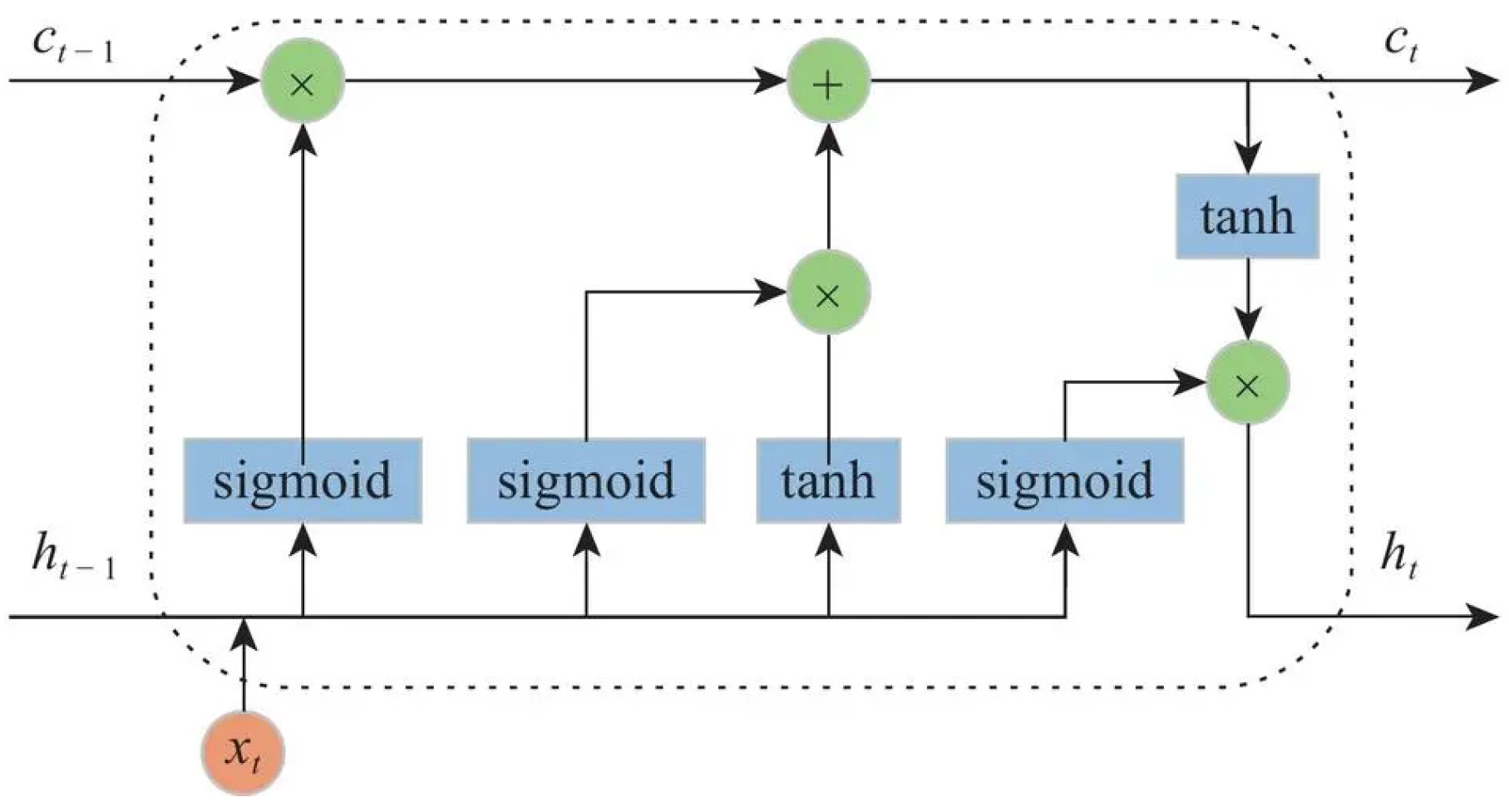

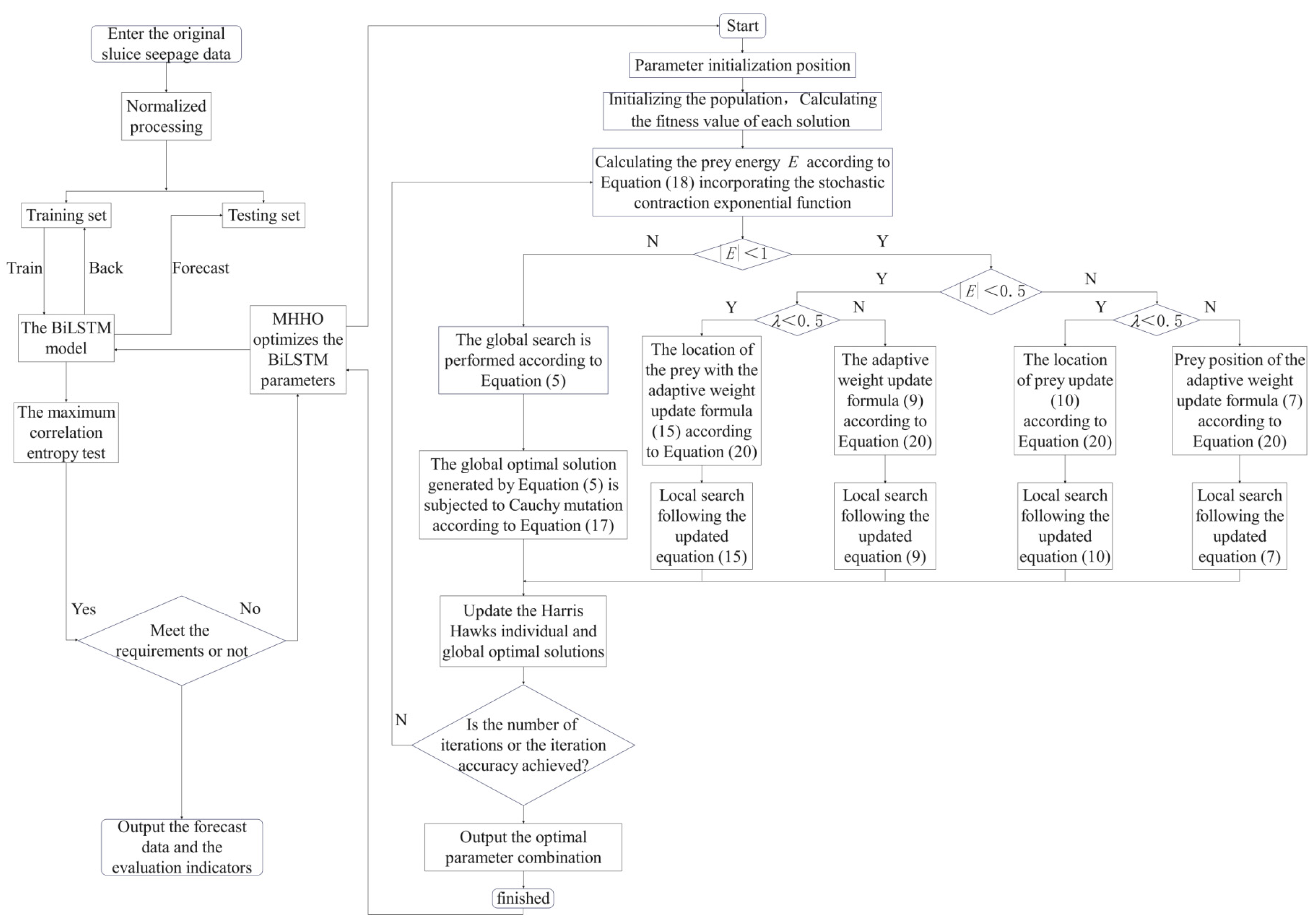


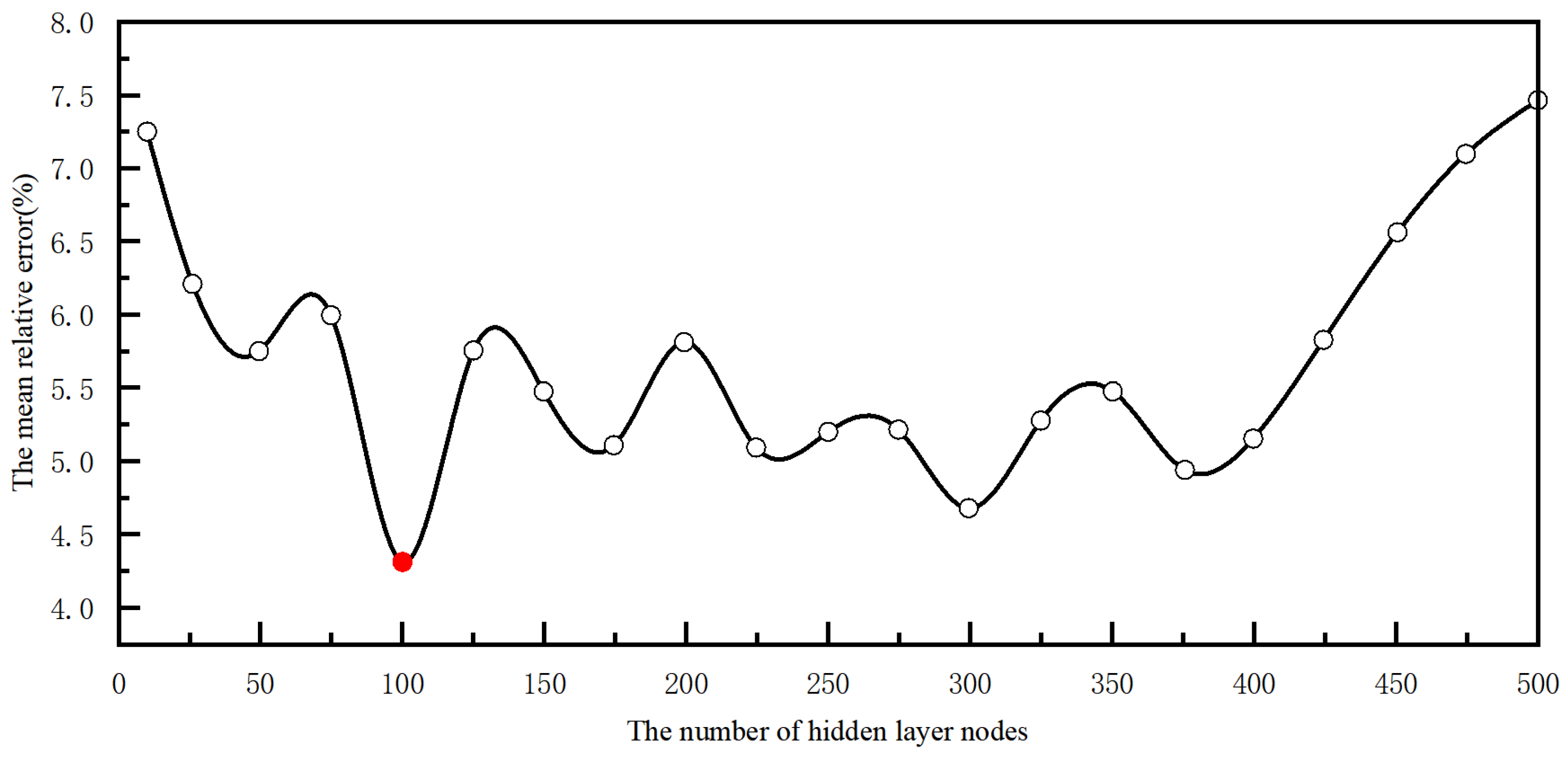
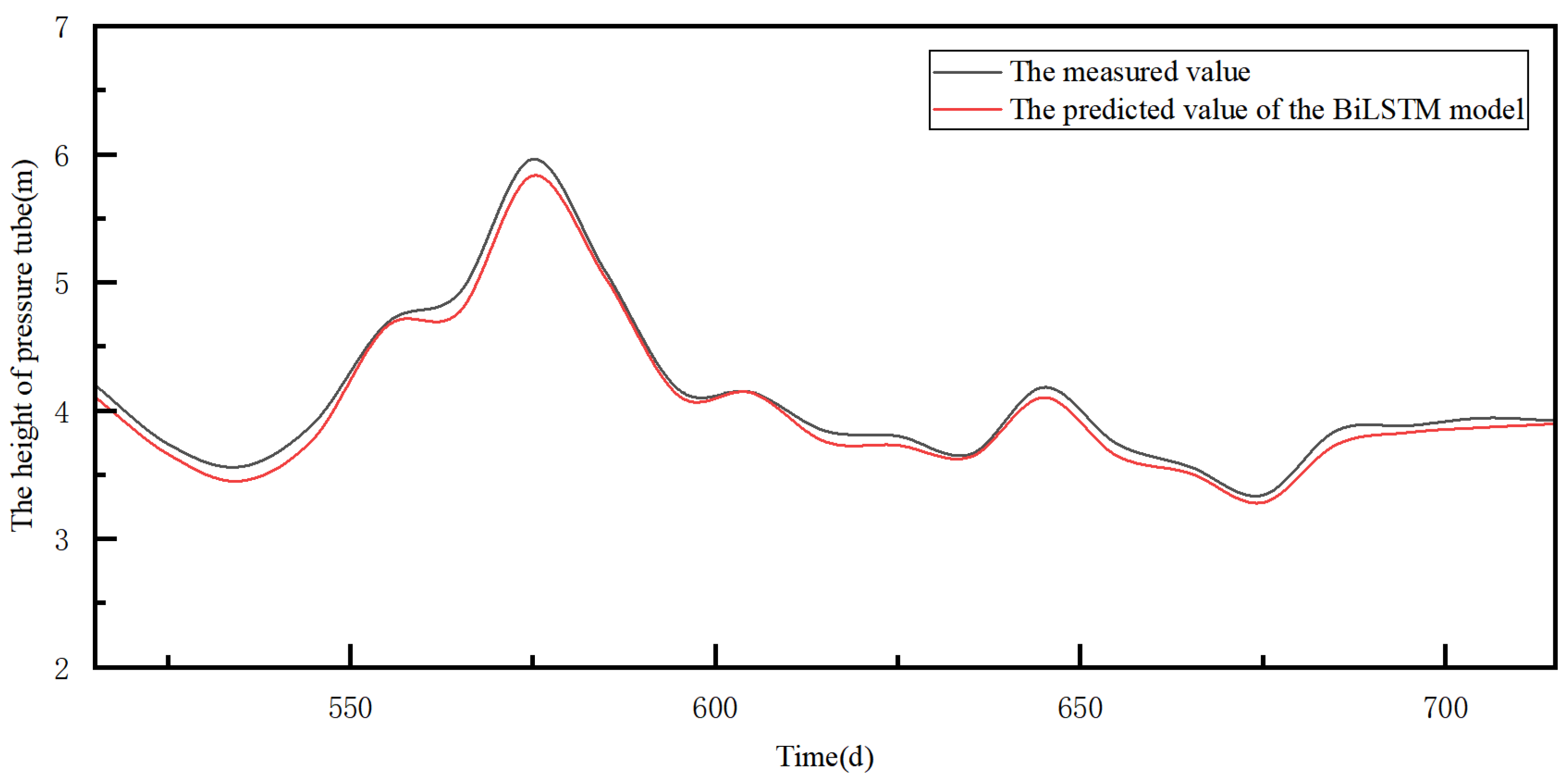
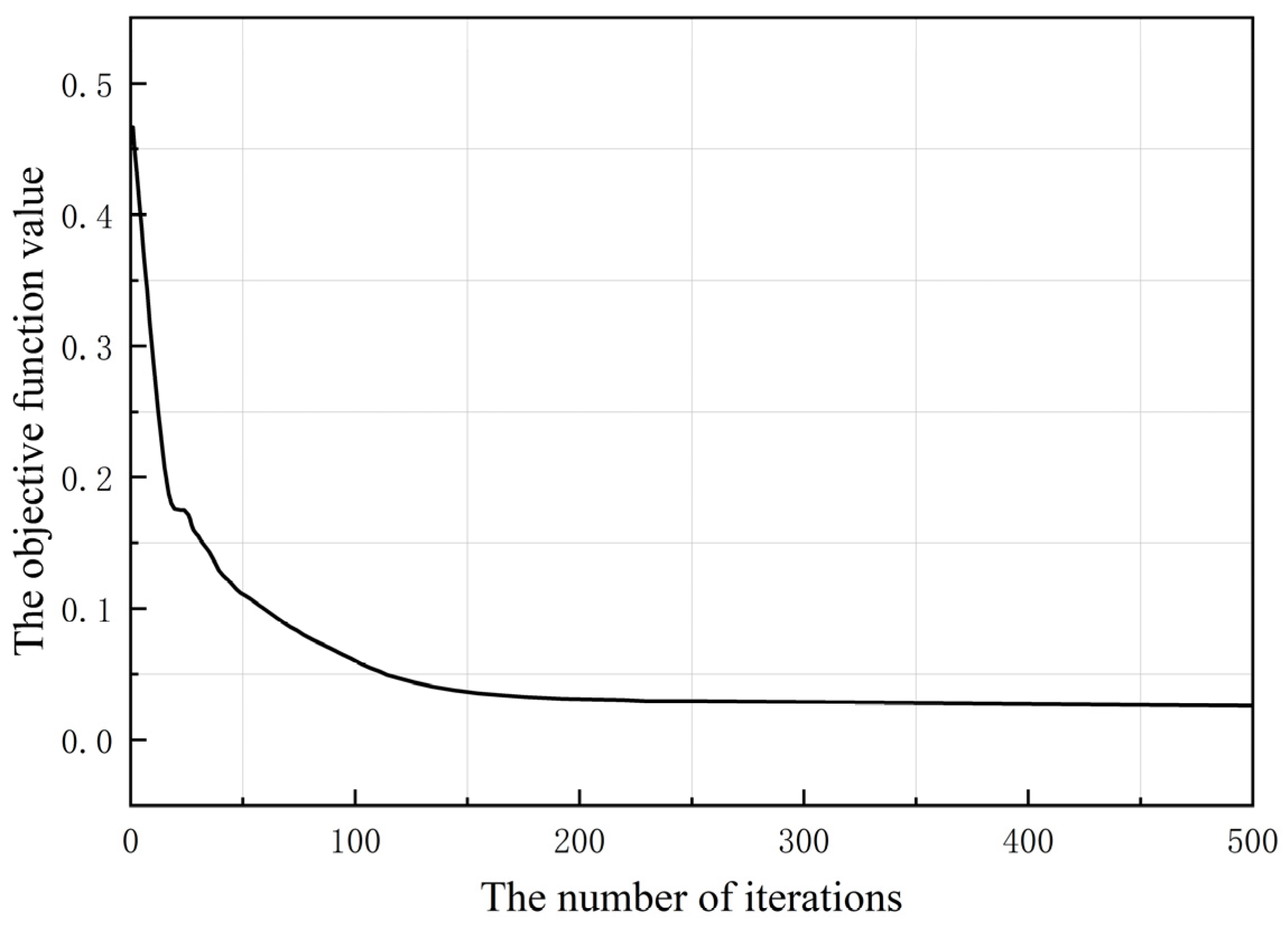
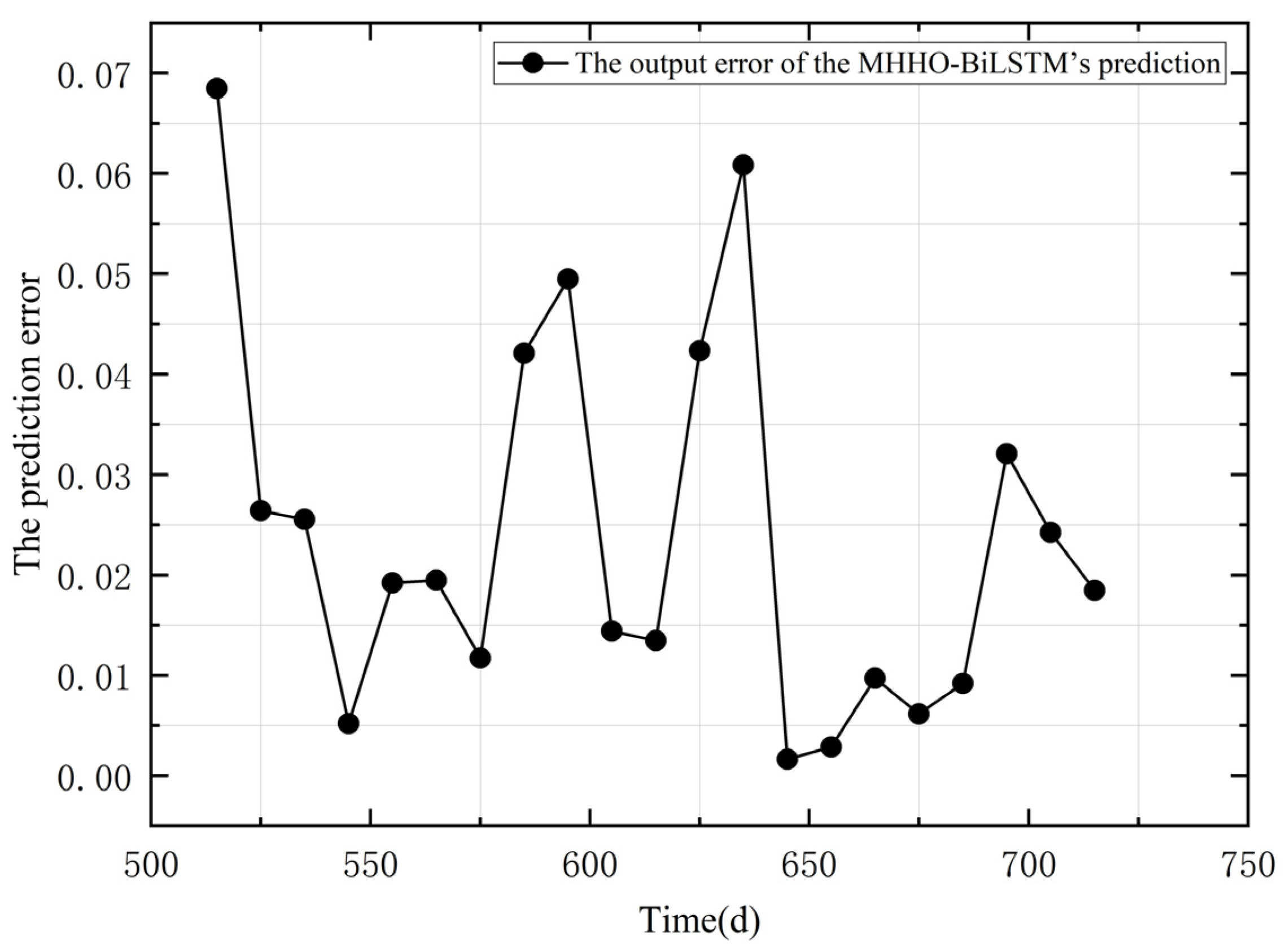

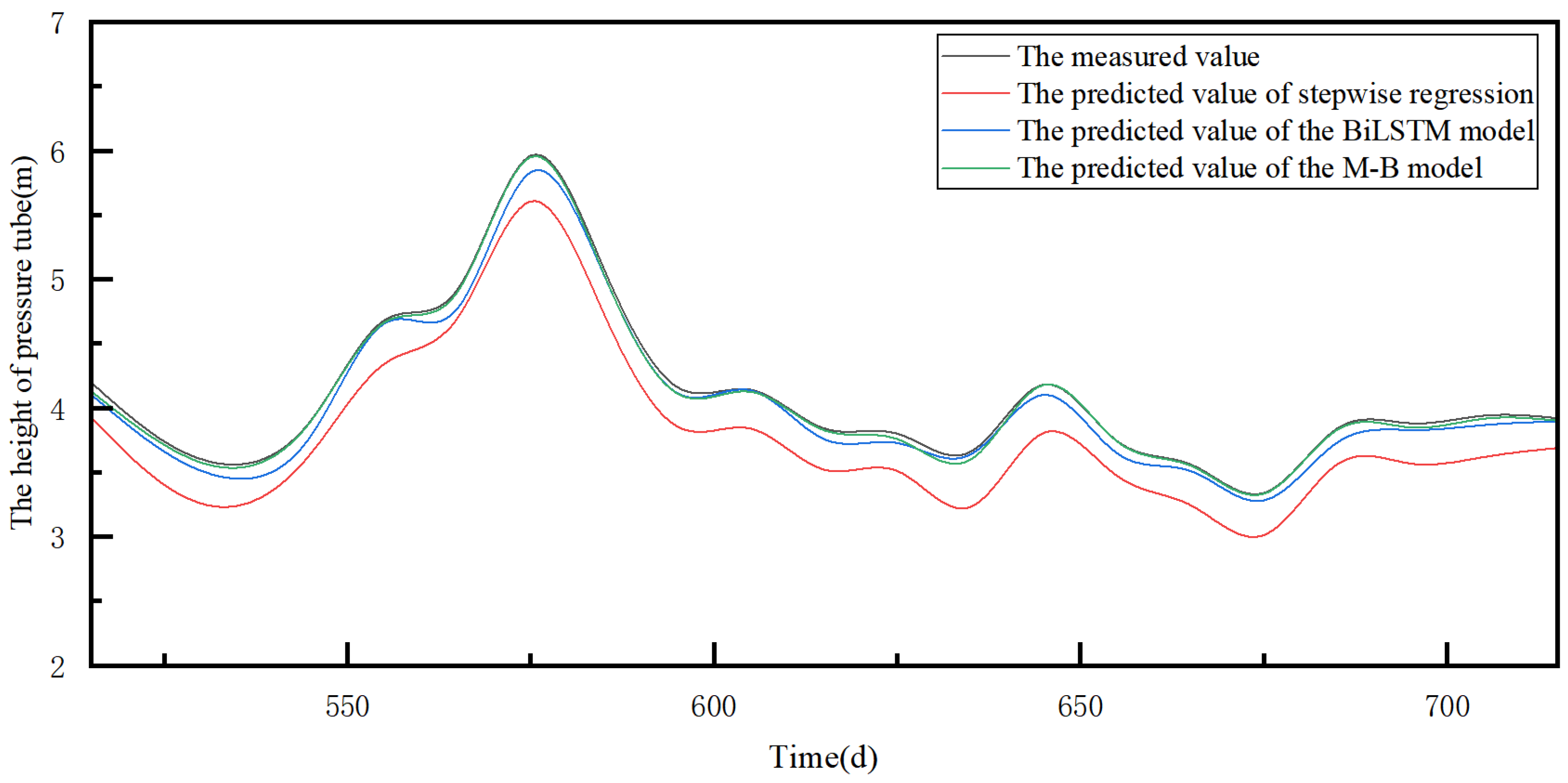
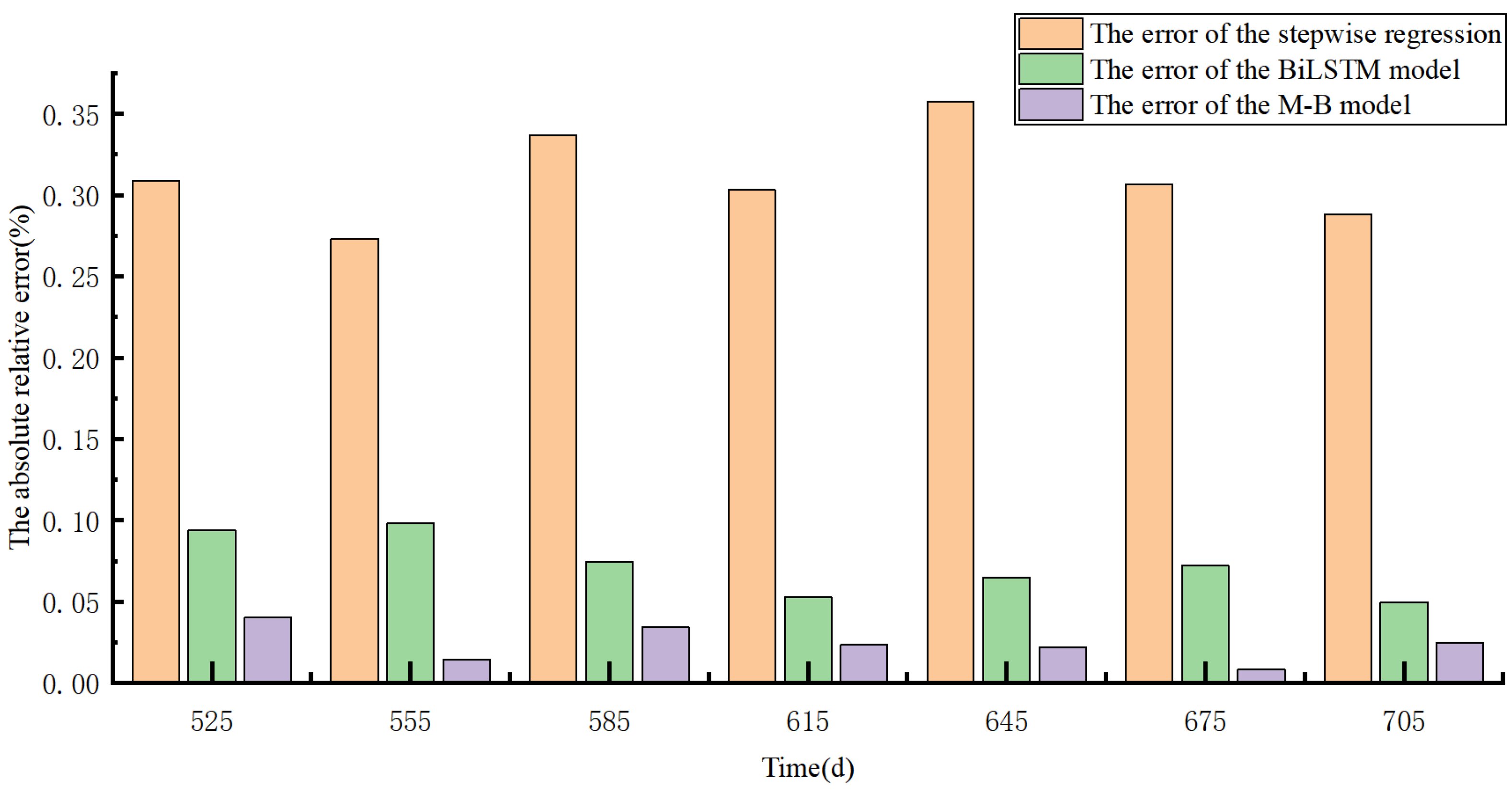
| Time (d) | The Height of Pressure Tube (m) | Time (d) | The Height of Pressure Tube (m) | Time (d) | The Height of Pressure Tube (m) |
|---|---|---|---|---|---|
| 515 | 4.2 | 585 | 5.08 | 655 | 3.74 |
| 525 | 3.74 | 595 | 4.16 | 665 | 3.56 |
| 535 | 3.56 | 605 | 4.14 | 675 | 3.34 |
| 545 | 3.9 | 615 | 3.84 | 685 | 3.84 |
| 555 | 4.68 | 625 | 3.8 | 695 | 3.88 |
| 565 | 4.92 | 635 | 3.66 | 705 | 3.94 |
| 575 | 5.96 | 645 | 4.18 | 715 | 3.92 |
| Time (d) | Measured Value (m) | Predicted Value (m) | Relative Error (%) | Time (d) | Measured Value (m) | Predicted Value (m) | Relative Error (%) |
|---|---|---|---|---|---|---|---|
| 515 | 4.20 | 3.92975 | 0.27025 | 625 | 3.80 | 3.50992 | 0.29008 |
| 525 | 3.74 | 3.40368 | 0.33632 | 635 | 3.66 | 3.23059 | 0.42941 |
| 535 | 3.56 | 3.24000 | 0.32000 | 645 | 4.18 | 3.80737 | 0.37263 |
| 545 | 3.90 | 3.64363 | 0.25637 | 655 | 3.74 | 3.47025 | 0.26975 |
| 555 | 4.68 | 4.34023 | 0.33977 | 665 | 3.56 | 3.24419 | 0.31581 |
| 565 | 4.92 | 4.69632 | 0.22368 | 675 | 3.34 | 3.01331 | 0.32669 |
| 575 | 5.96 | 5.60482 | 0.35518 | 685 | 3.84 | 3.56232 | 0.27768 |
| 585 | 5.08 | 4.72975 | 0.35025 | 695 | 3.88 | 3.56771 | 0.31229 |
| 595 | 4.16 | 3.85467 | 0.30533 | 705 | 3.94 | 3.61926 | 0.32074 |
| 605 | 4.14 | 3.83909 | 0.30091 | 715 | 3.92 | 3.68754 | 0.23246 |
| 615 | 3.84 | 3.52096 | 0.31904 |
| Time (d) | Measured Value (m) | Predicted Value (m) | Relative Error (%) | Time (d) | Measured Value (m) | Predicted Value (m) | Relative Error (%) |
|---|---|---|---|---|---|---|---|
| 515 | 4.2 | 4.10652 | 0.09348 | 625 | 3.8 | 3.72805 | 0.07195 |
| 525 | 3.74 | 3.66147 | 0.07853 | 635 | 3.66 | 3.63839 | 0.02161 |
| 535 | 3.56 | 3.45042 | 0.10958 | 645 | 4.18 | 4.10113 | 0.07887 |
| 545 | 3.9 | 3.7796 | 0.1204 | 655 | 3.74 | 3.64533 | 0.09467 |
| 555 | 4.68 | 4.65414 | 0.02586 | 665 | 3.56 | 3.50907 | 0.05093 |
| 565 | 4.92 | 4.77195 | 0.14805 | 675 | 3.34 | 3.28215 | 0.05785 |
| 575 | 5.96 | 5.83144 | 0.12856 | 685 | 3.84 | 3.73229 | 0.10771 |
| 585 | 5.08 | 5.03003 | 0.04997 | 695 | 3.88 | 3.82805 | 0.05195 |
| 595 | 4.16 | 4.11445 | 0.04555 | 705 | 3.94 | 3.86686 | 0.07314 |
| 605 | 4.14 | 4.13654 | 0.00346 | 715 | 3.92 | 3.89562 | 0.02438 |
| 615 | 3.84 | 3.75722 | 0.08278 |
| Stepwise Regression | The Model of the BiLSTM | The Model of the MHHO-BiLSTM | |
|---|---|---|---|
| MAE | 0.5351 | 0.4645 | 0.4631 |
| MSE | 0.0582 | 0.0120 | 0.0028 |
| RMSE | 0.2412 | 0.1095 | 0.0530 |
| R2 | 0.8923 | 0.9747 | 0.9942 |
| Time (d) | Measured Value (m) | Stepwise Regression’s Forecast (m) | Stepwise Regression’s Error (%) | BiLSTM’s Forecast (m) | BiLSTM’s Error (%) | M-B’s Forecast (m) | M-B’s Error (%) |
|---|---|---|---|---|---|---|---|
| 525 | 4.56 | 4.28 | 0.2766 | 4.48 | 0.0820 | 4.55 | 0.0107 |
| 555 | 4.49 | 4.22 | 0.2724 | 4.43 | 0.0595 | 4.48 | 0.0126 |
| 585 | 5.87 | 5.57 | 0.2980 | 5.76 | 0.1080 | 5.86 | 0.0149 |
| 615 | 4.48 | 4.16 | 0.3233 | 4.42 | 0.0612 | 4.45 | 0.0325 |
| 645 | 3.97 | 3.66 | 0.3131 | 3.89 | 0.0836 | 3.95 | 0.0191 |
| 675 | 5.03 | 4.72 | 0.3086 | 4.94 | 0.0930 | 5.00 | 0.0307 |
| 705 | 3.90 | 3.61 | 0.2858 | 3.83 | 0.0643 | 3.87 | 0.0210 |
Disclaimer/Publisher’s Note: The statements, opinions and data contained in all publications are solely those of the individual author(s) and contributor(s) and not of MDPI and/or the editor(s). MDPI and/or the editor(s) disclaim responsibility for any injury to people or property resulting from any ideas, methods, instructions or products referred to in the content. |
© 2024 by the authors. Licensee MDPI, Basel, Switzerland. This article is an open access article distributed under the terms and conditions of the Creative Commons Attribution (CC BY) license (https://creativecommons.org/licenses/by/4.0/).
Share and Cite
Huang, Z.; Gu, C.; Peng, J.; Wu, Y.; Gu, H.; Shao, C.; Zheng, S.; Zhu, M. A Statistical Prediction Model for Sluice Seepage Based on MHHO-BiLSTM. Water 2024, 16, 191. https://doi.org/10.3390/w16020191
Huang Z, Gu C, Peng J, Wu Y, Gu H, Shao C, Zheng S, Zhu M. A Statistical Prediction Model for Sluice Seepage Based on MHHO-BiLSTM. Water. 2024; 16(2):191. https://doi.org/10.3390/w16020191
Chicago/Turabian StyleHuang, Zihui, Chongshi Gu, Jianhe Peng, Yan Wu, Hao Gu, Chenfei Shao, Sen Zheng, and Mingyuan Zhu. 2024. "A Statistical Prediction Model for Sluice Seepage Based on MHHO-BiLSTM" Water 16, no. 2: 191. https://doi.org/10.3390/w16020191
APA StyleHuang, Z., Gu, C., Peng, J., Wu, Y., Gu, H., Shao, C., Zheng, S., & Zhu, M. (2024). A Statistical Prediction Model for Sluice Seepage Based on MHHO-BiLSTM. Water, 16(2), 191. https://doi.org/10.3390/w16020191







